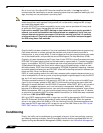
Firewall > QoS Mapping
470
SonicOS Enhanced 4.0 Administrator Guide
Enabling 802.1p
SonicOS Enhanced supports layer 2 and layer 3 CoS methods for broad interoperability with
external systems participating in QoS enabled environments. The layer 2 method is the IEEE
802.1p standard wherein 3 bits of an additional 16 bits inserted into the header of the Ethernet
frame can be used to designate the priority of the frame, as illustrated in the following figure:
.
• TPID: Tag Protocol Identifier begins at byte 12 (after the 6 byte destination and source
fields), is 2 bytes long, and has an Ethertype of 0x8100 for tagged traffic.
• 802.1p: The first three bits of the TCI (Tag Control Information – beginning at byte 14, and
spanning 2 bytes) define user priority, giving eight (2^3) priority levels. IEEE 802.1p defines
the operation for these 3 user priority bits.
• CFI: Canonical Format Indicator is a single-bit flag, always set to zero for Ethernet
switches. CFI is used for compatibility reasons between Ethernet networks and Token Ring
networks. If a frame received at an Ethernet port has a CFI set to 1, then that frame should
not be forwarded as it is to an untagged port.
• VLAN ID: VLAN ID (starts at bit 5 of byte 14) is the identification of the VLAN. It has 12 bits
and allows for the identification of 4,096 (2^12) unique VLAN ID’s. Of the 4,096 possible
IDs, an ID of 0 is used to identify priority frames, and an ID of 4,095 (FFF) is reserved, so
the maximum possible VLAN configurations are 4,094.
802.1p support begins by enabling 802.1p marking on the interfaces which you wish to have
process 802.1p tags. 802.1p can be enabled on any Ethernet interface on any SonicWALL
appliance including the TZ 170 Series, PRO 2040, PRO 3060, PRO 4060, and PRO 5060.
Note 802.1p tagging is not currently supported on the on the PRO 1260.


















